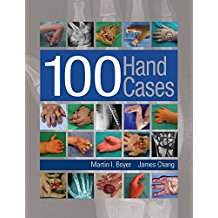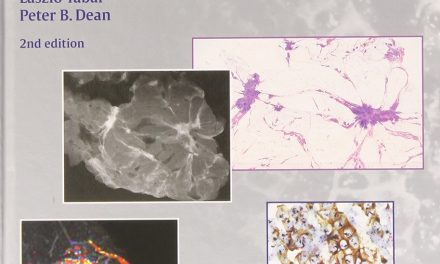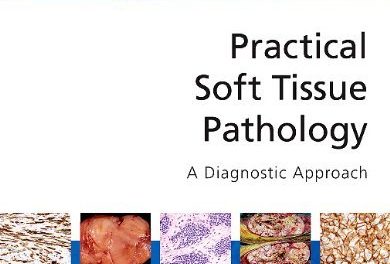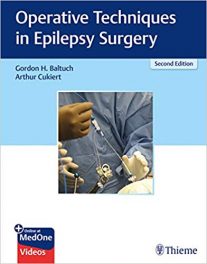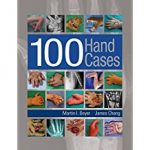 Authors: Martin I Boyer, MD; and James Chang, MD
Authors: Martin I Boyer, MD; and James Chang, MD
Publisher: CRC Press – 258 pages
Book Review by: Nano Khilnani
This is a concise and practical book on how to perform different types of hand and upper extremity surgery – from the shoulder to the finger tip, from the bone to the skin.
The authors have trained, over the course of 15 years at Stanford University and Washington University, hundreds of medical students, residents in orthopedic and plastic surgery, and hand fellows, how to perform various surgical procedures.
They have taught their students while standing in front of a patient, looking at a radiograph, or while settling in at an operating table.
“This book is designed for the learner to have an overview of the entire spectrum of hand surgery and to become familiar and comfortable with the most common hand problems. Key articles are listed for those who wish to delve deeper,” the authors write.
The 100 hand cases presented in this book are organized around 19 chapters, which we list below to provide for you an overview:
- Part I. Amputations / Fingertip Surgery
- Part II. Anesthesia and Pain Management
- Part III. Arthritis
- Part IV. Burns
- Part V. Compartment Syndromes
- Part VI. Congenital Conditions
- Part VII. Contractures
- Part VIII. Dupuytren Contracture
- Part IX. Fractures / Dislocations / Nonunions / Malunions
- Part X. Infections / Bites
- Part XI. Infections / Extravasations
- Part XII. Instability
- Part XIII. Osteonecrosis
- Part XIV. Peripheral Nerve
- Part XV. Soft Tissue Defects
- Part XVI. Tendon: Atraumatic Conditions (Tenosynovitis)
- Part XVII. Tendon: Traumatic
- Part XVIII. Tumors
- Part XIX. Vascular Conditions
Besides the content in this print edition, you can access other materials online: Do 3 steps below:
- Create a Vitalsource Bookshelf account at https://online/Vitalsource.com/user/new or log into your existing account if you already have one.
- Redeem the Code by scratching off the film on the scratch-off panel provided on the inside book cover.
- Log in to Bookshelf and click the Account menu at the top right of the screen. Select Redeem and enter the Code from the scratch-off panel
Go to http://bookshelf.vitalsource.com/ and follow the instructions to download the free Vitalsource Bookshelf app to your PC or Mac and log into to your Bookshelf account
Each chapter is typically just two to three pages long, and only one photograph is presented at the top of the beginning page in each chapter. This is to enable the student to focus on the problem at hand. The chapter outline is also very simple and elegant, containing the same following elements, with very little variation:
- Description of the Problem
- Key Anatomy
- Workup
- Treatment
- Alternatives
- Principles and Clinical Pearls
- Pitfalls
- Classic References
Let us take a look at chapter 3, Mutilated Arm Injury, found in Part I, Amputations / Fingertip Injuries:
The caption below the photo for this chapter reads: The patient is seen in the emergency department after a rollover motorcycle accident. The patient’s left arm was outside the driver’s seat window as the car rolled. He was stabilized in the field and transferred in a helicopter.
- Description of the problem: The patient has a severe mutilating injury of the left upper extremity. Skin and muscle loss is significant, with probable nerve and vessel injury and underlying fractures. The arm may be devascularized (total loss of arteries/veins/nerves). The wound is contaminated and will require emergent exploration, debridement, and repair.
- Key Anatomy: Knowledge of the entire anatomy of the upper extremity is essential to reconstruct this arm. Particular attention is paid to nerve pathways, flexor and extensor tendon function, and the vascular supply for flap coverage.
- Workup: This is a major traumatic injury in a patient with life-threatening injuries. The patient requires assessment and stabilization in the trauma unit. The cervical spine status may be evaluated. A full trauma workup is performed, beginning with the ABCs – airway, breathing, and circulation. Trauma surgeons must clear the patient for surgery. (The Workup is discussed in more detail).
- Treatment: The operation begins with irrigation and radical debridement. All contaminated and devitalized tissue is removed. In this case, a significant amount of muscle must be debrided. The skin and fascia are opened to prevent compartment syndrome. A carpal tunnel release is performed as part of the compartment release and to localize the median nerve.
(Discussion of the full course of treatment is discussed here, which includes a free tissue and muscle transfer such as the latissimus dorsi muscle flap or a fasciocutaneous flap such as an anteriolateral thigh flap will be required…)
This is one of the best textbooks available out there on surgery of the hand and upper extremities.
Authors:
Martin I Boyer, MD is Carol B. and James T. Loeb Professor of Orthopedic Surgery, and Co-Chief of Hand and Wrist Service at Washington University School of Medicine in St. Louis, Missouri.
James Chang, MD is the Johnson and Johnson Distinguished Professor of Surgery and Orthopedic Surgery, and Chief f Plastic and Reconstructive Surgery at Stanford University School of Medicine in Stanford, California.

